 Kent Coast Sea Fishing Compendium |
Feathering |
"Sea Fish & How to Catch Them" (1862) William Barry Lord at pages 100 & 101
Flies
The term fly is applied by sea fishermen to a certain arrangement of feathers, wax, &c., which I am about to describe the manufacture of, and which may be used with considerable success in mackerel, basse, and pollack fishing. I am not disposed to think, however, that such baits are ever mistaken by the fish which they are intended to capture for flies; but the number used, the way in which they are mounted, viz., several on one trace, and the method of their progress through the water, rather leads me to the belief that they are mistaken for a number of small fry, and treated accordingly. Hooks No. 5, Limerick trout pattern, should be tied on strands of stout gut with well-waxed silk. Finish off as shown in the woodcut describing the modes of fastening on hooks. Have your waxed silk long enough to work back over the body. After securing the end of a strand of red German wool at the tail, wind this evenly round the shank of the tied hook. When within a short distance of the head, secure the wool and nip off its loose end. Cut a long pair of wings from a white goose feather, lay them side by side, and whip them fast at the head, fasten off, cover the silk whipping at the head with melted red sealing-wax, covering all the space between the wings and the head of the hook, and the fly is complete.
Feathers dyed red are sometimes used with white, mounted alternately.
"Sea-fishing as a Sport: being an account of the various kinds of sea fish, how, when, and where to catch them in their various seasons and localities" (1865) Lambton J. H. Young at pages 64 & 65
Flies
Flies are used either with rods, as in river and lake fishing, or else by whiffing. White flies are found to be the best, and, when used of a night, large numbers of bass, mullet, pollack, or mackerel are taken. I have observed an old man-of-war's-man make a rough fly out of a large sea hook and some white pigeon feathers; the fly was put on a light line and the boat rowed at a good speed in a circle, and in nearly every case bass were taken, when his neighbours could not get a bite, and wondered at this man's success, who often returned with a dozen or more fish of large size as the result of his superior tact. In the River Dart some years since a clergyman used to drift in his boat with the flood tide of an autumn evening, and fish with the white moth flies, and by this plan obtain good sport; his salmon rod was severely tried by the strength of a fifteen-pound bass. Often any rough composition of red and white feathers on a hook, with red sealing-wax for a head, is dignified with the name of a fly, but I much doubt if a salmon or large trout would be taken in with such monstrosities.
"Practical Letters to Young Sea Fishers" (1898) John Bickerdyke at pages 120 to 122
XI: Baits Cast with the Fly Rod
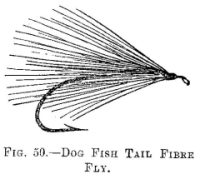
… Somewhat akin to these fish skin baits is a kind of fly made of fibres obtained from the tail of the dog fish. It was communicated to me by Mr. Moodie Heddel, of Orkney. The tail fin of the dog fish is first dried by hanging it up in the wind out of doors. When dry, the fleshy butt should be cut off close to the edge of the fin, and the dry skin turned down from each side. This operation discloses some ragged fibrous looking matter with a little dried flesh adhering to it. The Orkney fishermen cleanse the fibres by sucking them in their mouths and drawing them through their teeth, but those to whom this operation is repugnant may possibly discover a more civilized way of effecting the same object. The fibres when prepared are a pale yellow, and glisten beautifully in the water. They are about as thick as the bristles in a coarse toothbrush, and the illustration shows their appearance after they have been whipped on to the hook. These baits, which kill well, are worth taking care of; to wash them in fresh water and carefully dry them before putting away is not time wasted.
Feather baits for pollack and coal fish are deemed great medicine in the far north, and account for many large pollack and coal fish, called locally lythe and saithe. I am afraid these hardly come within the term flies, as they are much more often trailed than cast with a fly rod. They are, as a rule, very roughly made, a few turns of yellow worsted round the shank of a cod hook, and a couple of quill feathers on each side, not for wings, but laid flat along the shank to represent the sides of the fish. Black feathers may be introduced, and so may white. There is hardly any limit to the combination of colours which may be arranged. When the fish are feeding eagerly they are not very particular. The following dressings were recommended to me by Mr. Moodie Heddel, of Orkney:
- Take a large sized cod hook and cover it with a body of orange and black in alternate bars half an inch in width, and lay over the back of the body a few strands of peacock harle, or two whole feathers tied down to the tail. Wings, either white swan's feather or two whole speckled turkey or drake's feathers.
- Brown or grey turkey's feathers for wings, one or two curlew feathers placed farther back, and peacock harle on head and tail of body. Beads for eyes, red worsted round the gills, blue worsted along the back, and pale yellow, or greenish yellow, on the belly. (See Fig. 51.)
- Body, red and black worsted, with gold and silver tinsel. Tail of heron's feather cut out in the centre to make it forked, and a few strips ot peacock harle. For wings, two curlew feathers face to face, and, if it is a very long bait, two more feathers, or wings, further back.
These flies may, of course, with advantage be made on very large eyed hooks, but if these are not obtainable of sufficient size, large ordinary hooks can be used fitted with a long loop of twisted gut.
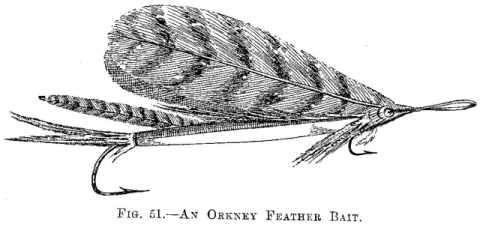
"Sea Fishing" (1911) Charles Owen Minchin at pages 286 & 287
Chapter XIX
Lines, Nets and Traps
Jiggering
… Jiggering is by some considered to be an unsportsmanlike and degrading pastime, but it is often a very useful method of procuring sand-eels, herring-fry and other small stuff for bait. The apparatus is simple and consists of a bamboo rod 6ft to 8ft long, a lead plummet of about 6oz which, if rubbed with quicksilver (Mr. Aflalo's tip), will shine better in the water, and about a dozen small hooks - sneck-bend No 12 - mounted on bristle and tied to the line at intervals of 4in or 5in above the lead.
Take up a position on the steps at a jetty-head or in the bows of a vessel anchored in the fairway, or at any other place where sand-eels or fry are passing, throw in the lead, which should reach mid-water or deeper, and then work the tip of the rod in a succession of semicircular dips, first to the left and then to the right. The French approach the sport of jiggering in a more serious way, and use an oval double-faced looking-glass about 3in long with a leaden rim and numerous small triangles, and they make quite large catches of herrings and sprats by this method, which is one much practised at Calais and other places where there are large deep-water harbours.
It requires some little skill and is very useful in providing for the wants of the frying-pan by getting hold of fish which perhaps could not be caught in any other way; so it seems perfectly legitimate sport and not at all to be sneered at by those who are not above going for a trout with what they call a "Devon minnow", in other words, 1½in of brass gas-piping, with numerous triangles whirling around it at various distances.
"Inshore Sea Fishing" (1939) W. S. Forsyth at pages 78 to 81
Chapter IV
Choice of Tackle or Bait
The Darra
This is really a team of flies, but with the sinker at the bottom of the team instead of being placed above it as for fly-fishing.
The sinker is placed in the water first and the line is allowed to run to the bottom. A slow trolling speed should be maintained either by rowing or by sail, and the flies jerked up and down in the water.
The Darra has been proved to be the most successful lure for mackerel. When mackerel strike the darra, one is inclined at first to believe that the sinker has become detached from the line or that the whole team has parted. This is caused by the mackerel swimming upwards and carrying the sinker with them. A few pulls will regain the tension and the catch may be hauled up. A mackerel is a very powerful fish for its size and the wisdom of having the sinker at the bottom of the team is recognized when the plunging, dashing mass flounders and splashes on the surface, rushing hither and thither and seemingly doing their utmost to tangle the tackle. The heavy weight at the end, however, prevents this happening. The fish should be taken off the hooks one by one as they are drawn over the gunwale, and not pulled on board in a mass.
The hard, horny-like dorsal fins and the sharp mouths, together with the dashing swiftness of mackerels do considerable damage to the gut of the Darra, and it is unwise to use the Darra more than two or three times. New tackle should be made. The clearness and sheen soon wears off the hooks and gut and the attraction decreases in proportion. The Darra should always be washed thoroughly in fresh cold water and hung up to dry. This applies also to fly-fishing tackle of any kind.
The Darra is often used in fishing for herring, but here a slight alteration in the position and nature of the sinker is necessary.
A round, pear-shaped sinker, having an eye at the side, Fig. 42, is attached to the line. The team is fastened to the eye of the sinker. This tackle is trolled a fair distance below the surface, hence the heavy sinker.
NOTE. In mackerel fishing with the Darra the sinker is at the bottom, while for herring fishing it is placed above the flies.
When the water is muddy or opaque, as in the estuaries of rivers, the Darra may not prove so successful as in the clear waters of the sea. In such cases, the clear metal spoon spinner, or any kind of spinner, may be used to advantage. Fig. 43.
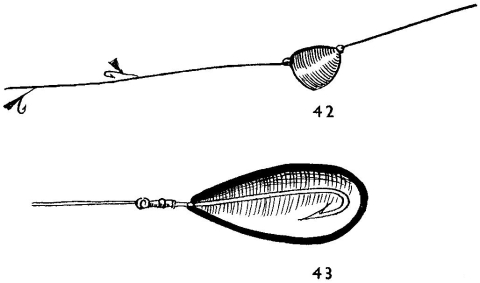
"Salt-Water Angling" (1956) Michael Kennedy at pages 215 to 218
Chapter 5: Float-Fishing and Drift-Lining
Feather Fishing
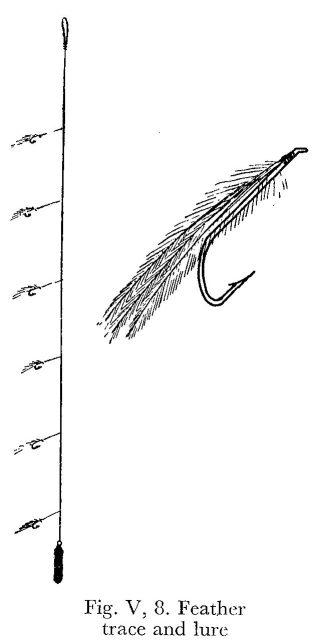
Feather fishing is a variation of the method of fishing from a drifting boat … differing from it chiefly in the nature of the terminal tackle, and the lures employed. It has nothing in common with fly fishing, though it is sometimes so described. An old trick of commercial fishermen in some districts, it is only in fairly recent years that it has been adopted by anglers to any large extent.
It is a somewhat controversial form of fishing, largely on the score of its efficacy. Anglers, for some reason, are prone to condemn a fishing method that results in the capture of a lot of fish! Admittedly, needlessly powerful tackle is sometimes used with the object of catching as many fish as possible, and this detracts from the quality of the sport enjoyed; but needlessly powerful tackle is also employed for many other fishing methods, with similar results. With appropriate tackle, feather fishing can yield first-class sport as well as good catches.
The tackle consists, essentially, of a monofilament trace (Fig. V, 8), about six feet in length, terminating in a lead of suitable size, and of a shape designed for quick sinking and easy lifting (e.g. a torpedo-shaped lead). At intervals, feather lures are attached to the trace, paternoster fashion by four-inch links of monofilament. These links should, for obvious reasons, be finer than the main trace; and there is a lot to be said, for the same obvious reasons, in favour of attaching the lead to the end of the trace, not directly, but by a few inches of light monofilament.
The feather lures should, as a rule, be dressed on size 2/0 hooks and need not be elaborate - all that is required is that they should be about two inches in length, and be dressed with mobile materials, such as hackle feathers. Ordinary tinned sea hooks may be used, or freshwater type hooks, lapped with silver tinsel covered with clear lacquer. Four to six cock hackles, tied in by the stumps just behind the eye of the hook, are all that is required to complete each lure. White, barred or badger hackles may be used, or a mixture of white and dyed hackles. Depending on circumstances, from three to six or more lures may be attached to the trace, the lowest fairly close to the lead.
Essentially a daylight, clear-water technique, feather fishing may be employed to take cod, pollack, coalfish, whiting and gurnard close to the bottom, and mackerel and shad in mid water. For near-bottom fishing, a light boat rod or a powerful spinning rod is best, and a lead of 4oz to 6oz may be required. A 20lb test line, 20lb test main trace, and 15lb test dropper links, will be necessary if fish are plentiful and run large. When the boat reaches a likely spot - a reef; an area of extensive rough ground; a mark where cod are known to be plentiful; or the like - the boat is let drift with the tide. The lead and trace are put over the side, and line is paid out until the lead touches bottom. A foot or so of line is then reeled up, the check put on, and the rod raised and lowered with a steady, pumping action.
As the lead is alternately raised through nine or ten feet by the upward movement of the rod, and then let sink towards the bottom again, the string of lures moves up and down, the individual lures quivering and sinuating like little fish. Their movement is attractive; they search up and down though nine or ten feet of water; and the drift of the boat means that new ground is being worked all the time. Results with cod are usually better than those achieved with natural baits fished on bottom tackle, and several fish may be hooked together. For daylight pollack fishing, the method is much more effective than trolling, for the ground is more thoroughly worked, and it is possible to get the lures right down to the fish. I have known two anglers to get over three hundred sizeable pollack in a couple of hours by feather fishing, on grounds where ten pollack would be considered a good catch by trolling.
For mackerel fishing in mid water, much lighter gear may be used for provided only two, or at most three, lures are employed. If a greater number of lures is used, since a mackerel is likely to be hooked on each lure, a light rod will hardly suffice! A stiffish threadline rod, with an 8lb braided line on a centre-pin reel, 5lb trace and 4lb dropper links, make up a sporting outfit, and a ¾oz sinker will probably be heavy enough if it is streamlined in shape. It is usually best to start by letting the lures down to about three fathoms below the surface where there are signs of fish, or where there is reason to expect them; to work the lures up and down between the three fathom and two fathom levels; and to try deeper or nearer the surface if results are not forthcoming.
A light form of feather trace, with half a dozen 1in lures dressed on size 6 to size 4 hooks, may be tried for herring where they are shoaling. Sometimes herrings will snap at bare, bright hooks without the addition of feathers!
"The Modern Sea Angler" (1958) Hugh Stoker at pages 67 & 176 to 178
Chapter Six
Rock Fishing
Finally, we must mention a method of rock fishing which is widely practised from rocky scaurs bordering deep water. This is the art of 'bobbing' with a trace of feathered lures, or a single cuddy fly made from a white gull's feather bound with tinsel. Both lures are worked underwater at slack tide, with short, quick jerks.
A close, still evening in summer or early autumn, when there is a thunderstorm brewing in the distance, is the time above all others to try one's luck with this kind of fishing. Under such conditions it is not unknown for fish to go suddenly crazy, snatching at practically anything. Then a bobbing trace and a lively rod will provide an evening of never-to-be-forgotten sport.
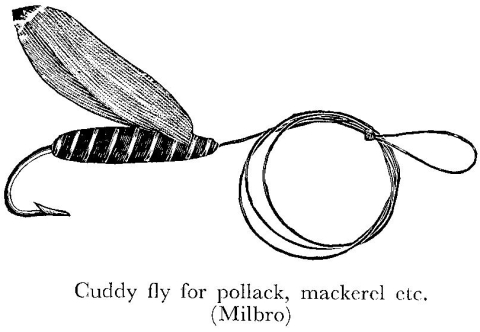
Chapter Thirteen
The Sea Angler's Workshop
Making Feathered Lures
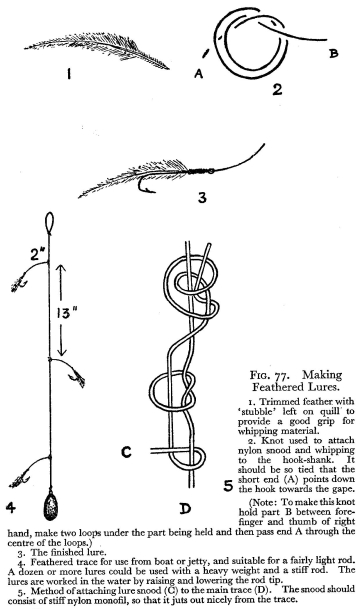
In an earlier chapter of this book we recommended the use of feathered lures for various kinds of sea fish, and as these are difficult to obtain in some districts, it might be a good idea to describe a simple method which will enable the amateur to make them up at home, or while away on holiday.
First of all, of course, you will need a supply of feathers. Those incorporated in shop-bought traces often cover a remarkable range of hues; but white and red are the only colours you need bother about.
Hackle-feathers from the domestic cockerel are very effective, but they are by no means essential, as some anglers declare. White goose or gull's feathers do very well; although not every feather from these birds will make a satisfactory lure. If possible, choose fairly small, thin, and compact ones from the wings or tail. They are easy to tie, and in the water bear a close resemblance to a small bait fish.
The hooks for your lures should be new, tinned, and fairly long in the shank. An assortment covering sizes 1, 2, and 3 is recommended, because - within reason - it pays to select hooks which suit the size and shape of the feathers.
Now for the method of tying the lures. First of all, with a razor blade, trim each feather as shown in Fig. 77, 1, so that a little over half an inch of bare quill is exposed. Leave a slight 'stubble' on the quill, as this will provide a better grip for the whipping material.
Select a length of nylon monofil snooding for the hook; slip it through the eye and tie the knot illustrated in Fig. 77, 2, around the shank about half an inch below the eye. Immediately above it attach one end of the whipping material by means of a similar knot, encircling both hook-shank and snooding.
Ideally, whipping thread should be used for this purpose. If this is not available, however, strong waxed button thread will do very well. Pull the knot in the whipping material tight, hold it between finger and thumb, and make a few neat, tight coils around the hook-shank and nylon snooding.
After about half a dozen turns, lay either one or two feathers (depending on their size and shape) along the hook, so that the bared portion of each quill is lying along the upper portion of the hook-shank as far as the opening of the eye. Then continue the whipping around hook, nylon, and quill until the eye is reached; finishing off with a secure, non-slip knot. Varnish the whipping and leave to dry.
This is just one of many basic methods of tying feathered mackerel flies. The real fascination of making up one's own lures, however, lies in trying out different combinations of hooks, types of feather, and so on. Don't be afraid to experiment - quite often results are improved by slipping scraps of tinsel or brightly coloured wool into the coils of the whipping thread.
"The Art of Sea Fishing" (1964) Laurie Robinson at pages 59 to 61
Chapter 6
Artificial Lures or Baits
Feathered Lures
Feathered Lures Lures of this kind have been used in the sea for many a long year. I had my introduction to these as far back as 1916 - a set of six that must have killed stones of pollack and mackerel fishing from a pier. If you examine a set of these in your local tackle shop you will realise that by freshwater standards these lures are crude. But they are effective and, what is more, they can take most types of sea fish, particularly when used from a boat. In 1955 when fishing Inner and Outer Torridon with the famous Alec Cameron of Shieldaig, I had eighteen different species, all of which took the lures or the darrah, as they are called in Scotland, by the mouth, with none foul hooked.
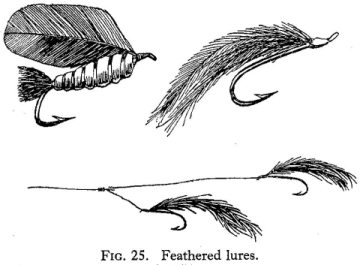
These flies are usually in casts of six or twelve, the six set cast is about six and a half feet in length and the twelve set around twelve feet. The former is by far the better, and can be used from the shore, though even here a set of three or four might be better. They are made up of thirty-six lbs BS nylon. While this breaking strain will be perfect for mackerel, pollack and school bass up to two lbs, when you fish in waters that hold big fish, as in the west coast waters of Scotland, the breaking strain of the trace will have to be much stronger, at least 45 lbs. Two or three pollack of six lbs a piece can be quite a handful, and put a severe strain on the snoods and trace.
There is no reason why you should not make these up yourself; the tying is simple, the feathers are easily obtained and the final cost shows a great saving, apart from the satisfaction of knowing you have made them. The hooks should be of the long shank variety. The tinned whiting size is ideal, while the feathers are easy to come by. You can collect all you want during a walk along the beach. These are from the gulls and they are waterproof. Failing this, the hackle feathers of a cockerel will answer the purpose just as well, providing also the necessary colour. The white feathered lure is usually most successful, though there are days when the coloured flies fish better. Feathers tapering to a point and those about three to four inches in length are most suitable. They are trimmed for three-quarters of an inch at the quill end, leaving a very narrow edge of feather along each side in order to provide a good grip when fastening them to the shank of the hook.
The cast is attached to the main line and an elongated lead of the barrel shape is fixed to the lower end of the cast. The method of working these is known as sink and draw. When fishing from a boat the cast is lowered into the water to the depth required, then the rod tip is lowered and raised. This gives the life-like action to the flies in the water. From the shore, pier or rock edges they are cast out, allowed to sink for a second or so, when the same lowering and raising of the rod tip is carried out, with this difference, that as you lower the tip you reel in the slack line each time.
"Sea Angling" (1965) Derek Fletcher at pages 155 to 157
Chapter 16
Flies and Feathers
One frequently hears of salt-water fish being taken on fly, but in most cases it would be more correct to call these 'flies' feathered lures. Compared with the delicate fly used by the fresh-water man, the sea-angler's version is decidedly crude and clumsy.
It is, however, true that bass are occasionally caught with salmon and trout flies. Such fly-fishing has only recently come into prominence. Anglers seeking new ways of taking fish find that this method calls for great skill and the landing of a fish, of course, gives the greater pleasure. But it is an uncertain way of taking sea-fish. One day it may be rewarding, but spells without success follow. One drawback, of course, is the winds experienced on our coasts. The rod and line has to be strong to drive the fly into the wind and casting on windy days is not pleasant and cannot be really accurate. It is better to wait for a comparative calm day to cast a fly at sea.
Several fish lend themselves to fly- or feather-fishing, particularly bass, pollack, coal-fish and mackerel. I have heard of mullet being caught but have never witnessed any taken. They are, however, inquisitive fish and it is possible that such reports are correct. Rock bass are the most likely to fall for feathered lures, and during spring off rocky coasts I have seen them attack such lures savagely. Generally they do not seem particular about pattern and a couple of white gull feathers whipped to a small-eyed hook work quite well. Coloured feathers of red and blue jerked over the surface have been equally effective.
Best results are had in the early morning when often a shoal of surface-feeding fish can be irritated to take the lure.
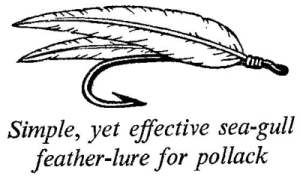
Pollack are also likely to be taken with feathers, especially in the West Country. On one occasion, using a trout-rod from rocks in the early morning, an angler took seventeen fish, all over 2 lb. His lure was made from the tail feathers of Rhode Island Red cockerels together with gulls' feathers. Eight fish were caught with two seagull feathers found on the rocks and which were whipped to a No. 5 sea-hook. This lure was taken freely in the late evening and several fish were lost. A tiny spiral weight was attached 3 ft. above the fly and long casts were made from the rocks. One pollack, nearly 6 lb., returned to attack the lure many times before becoming hooked.
There is little hope of getting pollack to take feathers in a rough sea. The water must be dead calm and the clearer the better. Long- or streamer-flies are remarkably effective at times fished from a boat. A jerky motion of the fly over the water will provoke interest; if the fish misses in its first attempt to connect the movement of the fly should be slowed up. Care must be taken not to alarm the shoal and a capable boatman is needed for a quiet approach.
An unusual lure was used with great success for coal-fish on the west coast of Scotland during 1952, and as far as I know is still used to get good bags of fish. Mr. L. T. Answorth, who told me of this method (he called it fly-fishing, although that is hardly the correct name for it), was, I believe, the first to intro-duce it in this area. It is a simple method. Several strands of grey wool are twisted around the shank of a large sea-hook, leaving ends of about 6 in. hanging below the point. To these ends two swan's feathers are tied. This is cast out, allowed to sink, and then retrieved slowly through the water. Mr. Answorth said that fish were taken at all states of the tides, and at times appeared mad to get on the hook. Exactly what the fish think this is I do not know, but there is no doubt as to the result.
Probably no coal-fish fly is more well-known than the simple Red Mike. To make it, wrap red wool on a No. 1/0 hook shank and then tie in two gull feathers, about half again as long as the hook. These are useful for tempting large fish at the edge of a tideway, particularly in Scottish waters. It has been found that best results are achieved in the early morning, particularly in thundery weather.
Mackerel-flies, with bodies of red and white, can be bought at most tackle shops and are quite effective if you are prepared to use patience and persevere if there is no success on the first occasion you use it. Sometimes fish can be seen on the surface within casting distance of rocks but mostly the method is to pursue them by boat. When a shoal is sighted it is best just to get within casting distance, keeping boat disturbance to a minimum.
A technique that is much used by so-called anglers is the feather-trace method. From some tackle shops, under the name of mackerel-flies, one can buy a set of twelve feathered hooks set at intervals on a long trace. These are deadly when towed behind a boat, or leaded and sent to the bottom and worked gently up and down. But this is not angling, since so many small specimens are taken and are often too badly maimed to put back safely.
Another fish sometimes taken with a fly-like lure is the garfish. A lure supposed to resemble floating seaweed, and made from a No. 5 hook dressed with gannet feathers took three fish off the south coast during June, 1953. Mr. R. Dyson, who was using this home-made lure for the first time, told me that knowing garfish frequent floating weed he thought that he would try out an imitation. He confessed that he was surprised at having results the first time he used it. But his success was short-lived, for on successive days he did not have a touch. On another occasion an angler showed me a garfish which he had taken with trout-flies from a pier.
"Feathering for Sea Fish" (1966) Fredrick William Holiday (aka "Ted Holiday") at pages 5 to 11, 125 & 126
Chapter 1: The Food of sea-Fish
Feathering techniques start to become effective when the preyed-upon species are of appropriate size. An appreciable size in this context means a creature large enough to be successfully imitated by dressing a hook with suitable materials. As a rough generalisation it can be said that anglers can satisfactorily imitate food creatures within a range of about ½ inch to about 12 inches in length. This covers a vast assortment of marine fare and includes many sorts of crustaceans such as amphipods, shrimps, prawns and small swimming crabs; the cephalopods such as squids and cuttlefish; the paddle worms; herring fry (brit); krill; sand-eels and elvers; sprats, together with the myriad young of the boney-skeletoned fishes.
All these food creatures are free-swimming and active as opposed to the various shellfishes, tube-worms and other bottom-dwelling creatures, which are not. The more nearly our feathers are designed to act and look like the specific food-form being eaten, the more eagerly they will be taken by the feeding fish.
Amongst British fish species which can be taken on feathers must be listed the following: hake, cod and codling, pouting, pollack, ling, garfish, mackerel, bass, gurnard, haddock, coalfish, herring and launce. Wrasse and dogfish are very occasionally taken on feathers. There seems no obvious reason why the predatory flatfish such as turbot, brill and large plaice should not be caught on feathers although I have not myself been successful with these latter fish. I believe they require a rather different feathering technique to that employed on the round fishes.
It may be useful here to compare the value of feathering with ordinary bait-fishing and spinning. Broadly, it can be said that the angler who uses bait is hoping to attract those fish which are feeding on static items on the sea-floor. Provided fish are indeed feeding on such items the bait fisher will do well. But if they are feeding on mobile creatures swimming through the sea then feathering beats bait-fishing every time.
The diet of a typical sea-fish such as the cod consists not mainly of food lying on the sea-floor but of fish and crustaceans … The food of cod - and, indeed all sea-fish - varies with the location and the season and, though it is of course true that cod do spend much time browsing over the bottom, the evidence suggests that this static fare provides only a minor part of their diet.
When we come to fish such as pollack, coalfish, bass, mackerel, whiting and garfish we find the bottom-feeding habit even less marked. Sprats, pilchards, brit, squid and sand-eels supply most, if not all, the diet of these fish.
It is clear, therefore, that the static bait is not, on average, the best way of contacting the greatest number of feeding fish at any given time. Most fish, for most of the time, are expecting movement from their quarry. And they are looking, not on the bottom, but into the swift flows of the tidal currents. This is why feathering, in so many cases, is the logical approach and the most productive method of all.
The angler who spins - whether from the shore or from a boat - certainly caters for the fish seeking a mobile prey. But the vast majority of spinning lures in common use such as spoons, Devon minnows, wobblers and so forth, aim to simulate only one basic food-form - the small fish. Sometimes this is the correct method and, when it is, then spinning does quite as well as feathering and a good deal better than bottom fishing. But when fish are feeding on amphipods, squids, swimming rag-worms, prawns and other creatures whose shape is not conveniently imitated by a metal spinner then the feathering technique not only beats spinning but is often the only way in which fish can be caught.
| Food Animals | Colour | Size | Shape | Found |
|---|---|---|---|---|
| Sand-eel or Launce | Bluish or greenish-yellow | Large (8-12in) | Very elongated | Found in the lower levels of tidal streams in summer and autumn |
| Brit | Silvery | Small (1-2in) | Compact | Found at fringes of tidal streams and in backwaters and inlets in spring and summer |
| Sprat | Silvery | Medium (3-4in) | Compact | Shoals near bottom of deep tidal streams in open harbour sea or deep harbours. Winter |
| Cuttlefish | Striped, black and white | Large (6-8in) | Elongated | Found in open sea also sheltered bays and estuaries in spring and summer |
| Prawn | Grey | Medium (2-4in) | Compact | Shallow in-shore waters in late summer |
| Shrimp | Grey | Small (1-2in) | Compact | Shallow in-shore waters especially over sand in summer and early autumn |
| Paddle worm | Blue, yellow or brown | Large (6-12in) | Very elongated | In-shore water during summer. Favours rocky shores with beds of laminaria |
| Sparling | Greenish | Medium (6-8in) | Elongate | Estuaries and harbours in summer and autumn |
| Elver | Greyish silver | Medium (3-4in) | Very elongated | Estuaries, tidal creeks and backwaters in spring and early summer |
| Fish fry, various | Silvery | Small (1-3in) | Compact | Sheltered harbours and inlets. Summer and autumn |
From this list it will be seen that small mobile food-creatures are present in greatest numbers in spring, summer and early autumn. Since fish are attracted to feathers most readily when they are actually feeding on swimming creatures, it follows that the optimum time for feathering is summer when the small food-forms are most abundant. However, it is not quite this simple; nature seldom is simple. In early winter, for example, one may get shoals of sprats massing in shore and pursued by codling, pollack or ling. In these circumstances cold weather feathering can be very productive.

Feathering in autumn and early winter, however, is subject to another factor. Storms stir up the sea and the water turns greyish-green with concentrations of salts and plankton. This condition is bad for any form of angling which relies on the fish seeing the bait as opposed to smelling it. If the sea looks opaque or "milky" the feathering method is not likely to produce results. Slight colouration coupled with good sunshine often produces good catches however.
A fundamental factor in feather fishing is the depth of the water. Broadly speaking, nearly all sea-angling around Britain is conducted in water ranging between half a fathom to thirty fathoms deep. Fig. 1 is a guide to the depths at which feathering is likely to be most effective in different conditions and at different seasons. In strong summer sunshine feathering is seldom effective in much less than 10 fathoms and on a brilliant June day it may be as much as 12 fathoms. Conversely, on a dull day in late autumn, fish can be caught much nearer the surface.
It should be stressed that this table is only a guide to general probabilities. On a dark stormy day I have taken fish a few feet below the surface, and in calm settled conditions have sometimes had to go as deep as 20 fathoms. However, as a practical guide on the best depth to feather in differing conditions I don't think it is far wrong as a working diagram.
Why should depth be important ? The answer lies in the realm of fish vision, light penetration of water and the instincts of predatory fish. No fish is biologically stupid. The stupid (or non-adaptable) ones quickly become extinct. Each fish in the sea has sharp instincts designed to keep it alive and flourishing.
Sea-fish have no experience of feathers containing hooks; nor can they reason. On the other hand, they know quite well by instinct what their natural prey looks like and how it swims. The more nearly a feathered lure resembles the fish's natural food the closer it can be successfully fished towards the surface, other factors being equal. And … it is possible to fish on the surface itself and catch fish. Surface lures of this sort, however, are fished in a special manner. On the whole, therefore, it must be repeated that most forms of feathered lure need to be sunk moderately deeply so that the gloom of the deep sea augments the art of the angler and the fish betray themselves by jumping to the wrong conclusion. They rarely make this fatal mistake if the feathers are brilliantly lighted.
The tides, of course, affect all sea-angling and every sea-angler should learn as much as he can on the complex subject of tide-streams and how they affect his particular part of the coast. It should be pointed out that most of the sea-fish of interest to the angler are migrants. The tidal currents of the sea are their highways and it is along these that they hurry. Often they pause to see if the traffic following behind them on the road is edible. We call these pausing-places "marks" and a thorough appreciation of them is essential if sea-angling is to be something more than a hit-or-miss affair.
The tidal state varies enormously from one station to another. Its effect on different species of fish is so wide that a comprehensive picture is possible only if each species and the different types of venue are dealt with individually … it should be noted that, on the whole, the top half of a making tide offers the feathering angler his best opportunities.
… The tidal flow can be both a help and a hindrance. The surging torrent of green sea-water brings in both the fish and the food that fish eat. But - especially on spring tides - it poses serious problems of boat and tackle management. Most anglers, including myself, prefer to fish the neaps. One reason is that it is much easier to show the feathers to fish in a moderate current than it is when the sea is a booming torrent. Even more important, on neap tides fish are much more inclined to linger on the marks than is the case when the powerful currents of the springs are whirling their food inshore at speed.
Chapter 12: Wider Applications of Feathering
The fact of the matter is, however, that feathering is probably the most deadly of all methods of catching sea-fish on a rod and line simply because it is the only method which exhibits to the fish what appears to be its natural prey swimming freely in the sea. No angler who is interested in taking substantial catches of fish home for his own or his friends' tables can afford to ignore feathering. Yet no British book on sea fishing that I can trace gives the method more than a few paragraphs.
… At many venues it is common to find that up to two hours must be spent getting bait before one can fish. The angler who goes feathering however can start fishing right away. This makes the method of particular value to visitors who have probably neither the tools nor the local know-how for bait-collection.
"Feathering for Sea Fish" (1966) Fredrick William Holiday (aka "Ted Holiday") at pages 29 to 32
Chapter 3: Tackle for Feathering
Some leads are suitable for feathering and some are not. The criterion is the shape. Leads for feathering should be long and narrow with either a round or a square cross-section. This ensures that they sink fast without a lot of turbulence and rotating. The "Arlesey Bomb" makes a good feathering lead if you can obtain them in the larger sizes. Never use watch-shaped leads or triangular leads for feathering; they are designed for ground-fishing.
For feathering from boats, piers and jetties one needs a supply of torpedo or "Arlesey Bomb" type leads in two sizes - 4 ounce and 6 ounce. In a strong tideway it is sometimes necessary to fish as heavy as a pair of 4 ounce leads or of course to use a single 8 ounce. Experience shows that when the tide rips past so fast that one cannot touch bottom with an 8 ounce lead and the line is being dragged far down-tide then feathering is usually ineffective …
The beach and rock fisher also needs lead but in much smaller quantities. The most useful form of lead for this purpose is a quantity of drilled bullets of ⅜ of an inch in diameter. These can be bought … For rock fishing a bit of sheet lead is also useful. Thin strips can be cut off and bent over the line or over the eyes of the swivels as occasion demands.
End-tackles, including traces, vary accordingly to the feathering method in use and the species sought … The idea of using several feathers on one trace is not motivated by greed necessarily. The chief reason is that it enables the angler to fish in several different levels of water simultaneously. Usually the bottom two feathers catch most of the fish although this is not always the case. The only time that fish attack all the feathers at the same time is when a dense and deep shoal of fish is encountered. Usually these are either mackerel or herring.
"Feathering for Sea Fish" (1966) Fredrick William Holiday (aka "Ted Holiday") at pages 38 to 46
Feathering: General Considerations
Feathering from Piers
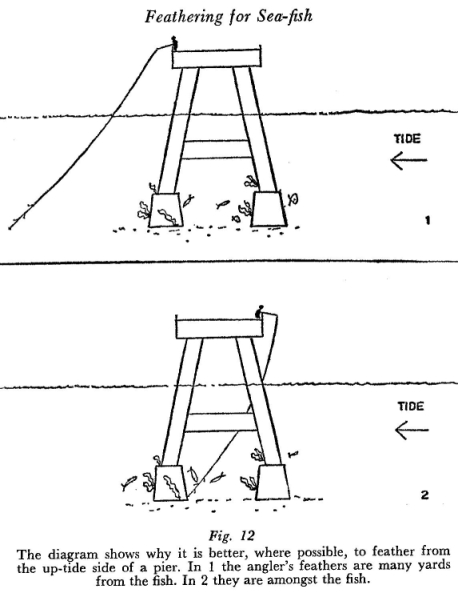
… Wherein lies the value of a pier ? It is really very simple. Pelagic sea fish stream in shore on the making tide in search of food. Imagine for a moment the featureless underwater expanse of level sands and shell-grit. They are in fact water-covered deserts and contain little to support life. There is nothing here to hold or interest the fish and they sweep along with the tide. Suppose, however, that you drive a few hundred piles into the sea-bed to carry a pier. Fairly soon they are covered with weed; and in the weed there will soon be shrimps, prawns, sea-slaters [1], crab larvae and much besides. The piles in fact have created an artificial larder or "mark". Naturally, the incoming fish make a beeline for the spot.
… The angler has decided to give feathering a trial from his local pier. What sort of feathers should he use, when should he use them and how should they be fished?
As a start I would suggest using single hook lures with a tinsel body and a streamer wing of white hackles. Three on the trace is plenty for a preliminary trial and a 4oz lead should be ample in order to take them down in everything barring a spring tidal stream.
The angler should lower his feathers from the uptide side of the pier. This is important and Fig. 12 shows why. The fish are feeding close into the piles. This means that if the angler fishes from the downtide side of the staging his lures will be swept many yards from the fish. The distance of course will depend on the size of lead in use and the speed of the tide. By fishing from the uptide side he can place his lures right amongst the fish.
Since your feathers are going to fish down and under the pier one must take precautions against becoming snagged. A couple of old coachbolts on a handline are useful for finding where the snags are and where they are not. Once you have found a clear spot don't be tempted to shift.
With some piers you can't fish in this way due to cross-staging and structural ironwork. There are several possible solutions here. You can fish from the end of the pier itself or if you can fish from the downtide side using a heavier lead which will keep the feathers nearer the piles. However - and I repeat - the feathers must fish near the piles.
This is not a theory dreamed up; it is based on observed fact. More than once I have been in a boat moored … 100 yards or so above our oil-piers. Combing the water with our lures we proved conclusively that the fish were feeding within a yard or two of the piles themselves. All the intervening water was barren. Yet it is only common sense when you think about it. Guests at a dinner-party don't stand 50 yards from their plates !
Now a bit about the way to fish the lures. Allow the lead to touch bottom, raise it a couple of feet, then lower it again. Don't jerk the lead. The movement is smooth and rhythmical and rather like fishing a minnow dip-and-draw for trout. Keep the feathers in quiet see-saw motion without any jerking or snatching.
If this doesn't produce results then reel the lead a yard or so from the bottom and continue working the lures. It is impossible to be sure at what level the fish will be feeding and at the start - especially at an unknown venue - it is largely a case of trial and error.
If still nothing happens you can have a ten minute rest while you watch your fellow-anglers catching crabs and whiting of about 3 inches in length. They probably think you are a lunatic to be pinning your hopes on a bit of feather and tinsel. But you are grinning at them for rushing to buy expensive boxes of lugworm half of which they will dump in the sea before they leave.
… If the pier you usually fish is of the shallow type don't be too disappointed if you fail to get offers to your feathers when the tide is low and the sunshine bright. Use ordinary bait-fishing methods for a while till the tide builds up and the sky clouds over; then try again with feathers. At some stage in the tide, provided the fish are there, you are nearly bound to get results.
Piers - Species Caught by Feathering
The species one is most likely to catch from piers using the feathering method varies with the geographic location of the pier and the season. In summer, mackerel and bass figure prominently in the catches from south coast piers; in the north one would expect mackerel and coalfish. In winter most of the fish in your bag at the end of the day will be codling, whiting and pouting.
One of the fallacies which has grown up in sea-angling is to regard codling and cod as bottom-feeders, invariably and entirely … On occasion I have seen cod with sizable bass struck in their gullets. Like most pelagic fish they are active predators.
On the east coast the codling come in on the currents generated by northerly gales. Moving south towards the Channel they feed heavily on brit, fish fry and small whiting as well as browsing on crabs, prawns and worms.
How wrong anglers are to wed themselves to a bait-rod when, in point of fact, they should be feathering. When codling are chasing brit yards from the bottom it is a pretty silly exercise to sit over a lugworm anchored to the sand … Piers are a great comfort to shoals of brit beset by hungry codling. The piles are a great comfort to shoals of brit beset by hungry codling. The piles and the masses of streaming weed do offer a sort of shelter. Codling feeding in this manner will have no hesitation in taking feathers if these are fished at the appropriate level.
Whiting also are brit-feeders as well as being cannibals to boot. This being so, they will take feathered lures readily. It is here that we encounter another advantage offered by this method of fishing. Whiting shoals are frequently harassed by packs of spur-dogs and lesser spotted dogfish … Very seldom indeed do you hook dogfish on feathers but you catch plenty of whiting and this, to me at least, is a great point in favour of the method.
Big whiting like a good depth of water - say 8 fathoms or more. The shoals come sweeping in on the tide looking for what they can devour. Often this turns out to be a small whiting (which have been shoaling round the piles of the pier at low water feeding on small crustaceans and other fare). The cannibals adopt shock tactics, diving into the shoals of babies from all angles. While this is going on the feathers will do well. Then the shoals of young whiting scatter and flee into the broad waters of the sea and their predatory elders cruise on looking for another compact group at the next pier. Thus the sport tends to fluctuate according to what is happening under water.
Whiting come best on the feed in late afternoon especially when this is the time of a making tide. Since they are largely a winter fish and the actinic value of the light is poor late in the year there is much to be said for using bright lures, especially in deepish water. Double hook feathers with plenty of tinsel and yellow fluorescent chenille is a good recipe.
Feathering from Jetties and Breakwaters
Feathering from deep water jetties can be a quite deadly method of fishing. If there is about 8 fathoms of water you will catch fish even in bright conditions. If the water is not as deep as this then give the jetty a trial in the evening when the shadows begin to lengthen. It is usual to get best results towards the top of a making tide.
It is quite astonishing the size and quantity of fish which will nose around a good jetty - especially an old one with plenty of cracks in the structure full of big sea-slaters. Bass, pollack, whiting and pouting will be around if the tide is right. Around the jetties in deep water harbours you will get mackerel, garfish and even small tope …
When feathering from jetties it is customary to lower the tackle down by the face of the retaining wall. Before doing so, however, carry out a spot check by using an old handline with a couple of coachbolts on the end to make sure there are no ancient ships' cables and other junk below the water. Many jetties too contain projecting rings for mooring boats which will readily foul one's tackle. As a further precaution against snagging it is a good idea to tie your feathers on fairly short snoods.
… Never be afraid to experiment with different sizes of feathers. If the fish are feeding on tiny brit about ¼ inch long they will show no keenness to seize a hairy double hook lure measuring 4 or 5 inches overall. Of course they don't reason it out; it's simply that they get into a feeding routine. Like Pavlov's famous dogs they have become conditioned, temporarily, to snap at ¼ inch long brit and nothing else will do.
… Breakwaters vary in design and quality but the fact is that they are constructed essentially as devices for breaking the seas, not for making fishing easy. In practice this often means that the breakwater wall is flanked for some distance to seaward with concrete groins to break up the surf. Masses of concrete blocks and large boulders are often dumped along the breakwater with the same idea in view - to deflect and damp the weight of the seas before they reach the main structure.
In very fine weather the active angler can sometimes clamber out on to these obstructions and fish his feathers into green water-filled caves where fat pollack lurk. But more often than not he is forced to remain on the main structure and has to get his feathers to the fish by casting. …
[1] Editor's Note: (Ligia oceanica) a littoral woodlouse.
"Competition Sea Angling" (1970) Bruce McMillen at page 40
3. Baits and Lures
Feather Lures
These can be used either singly or on a trace holding a number, and will account for a great variety of fish including mackerel, pollack, coalfish, codling, whiting, bass and sometimes even tope. I believe it is an advantage to attach a strip of fish to these lures, and by using a single feather on light trout tackle, superb sport with mackerel can be enjoyed. While feather lures are often used for spinning, they are more usually associated with 'jigging', a method in which the lure is raised and lowered for several feet at a time at a depth at which the fish happen to be feeding at the time. The exact depth can only be discovered by trial and error. When the fish are discovered, mark the reel line with a twist of wool or cotton so that you can readily find the correct depth immediately you recast.
"Estuary Fishing" (1974) Frank Holiday at pages 32, 33, 63 & 64
Chapter Two
Boat Fishing
Tackle, baits and lines
The method is ideal for use from a boat since the fisherman is presenting the lures to a quarry almost directly below him. He thus has far more positive control over the lures than does an angler casting from the shore or manipulating them from a pier-head … feathers can be used whether the boat is at anchor or is on the drift. Indeed, feathering … on a drift is an excellent way of discovering new marks even though one may lose some tackle in the process.
Chapter Four
Baits - Natural and Artificial
Artificial baits
As regards artificial baits we will first consider the case of the boat angler. Certainly he will want 'feathers' - that ubiquitous lure for catching mackerel, whiting, pollack and other fish. These are made with ease by whipping bucktail, plastic strips or hackles to a suitable hook. For general fishing I like to have two types - a white hackled, silver bodied lure of goodly size for dull sea conditions and a smaller, more sober lure for bright conditions and shallower water.
Feathers are usually spaced up the trace paternoster-fashion. Three are plenty to use at one time even when the object of the exercise is merely to obtain a quantity of mackerel for bait. If more than three feathers are used then some hooked fish will probably tear themselves free and this seems to me a repulsive way of fishing for sport.
Feathers can also be used from the shore and I have had many mackerel, pollack and other species by casting feathers from rocky venues fringing deep water using beach-casting gear and recovering the lures in a series of hauls on the dip-and-draw principle. You need at least 3 fathoms of water and no more than four ounces of lead to succeed at this game otherwise your tackle lossess will become prohibitive. Considerable skill is needed in that the feathers must be brought towards the surface progressively as the water becomes shallower and the weed-growth thickens.

The Daily Express, Friday 7 June 1975 at page 15
Fishing by Clive Gammon
The fly way to catch a silver
They look just like herrings that have swallowed the contents of one of those "Drink me" bottles in "Alice In Wonderland".
They have the same silver scales, the same general appearance. Only they weigh up to 200 lb. and more, and in Florida they call them "silver kings." Or, more commonly, tarpon.
I'd heard of tarpon before, of course. But until I went fishing in the Florida Keys earlier this month. I hadn't realised that some far-gone enthusiasts went after them with fly rods. Fairly powerful 9ft. fly rods, but no tougher than the ones used for salmon in this country.
And while most of the cast is made up of 80 Ib. test nylon, to prevent its being frayed on the tarpon's tough jaws, a short length – 9-10 in. - of 15 lb. nylon is included. It must be the ultimate in light tackle sea fishing. And a 100 lb. Tarpon can hold an angler up for two hours or more.
The fly itself is a long streamer - red and orange are favourite colours – mounted on a 4/0 hook.
Frankly, because I wanted to chalk up a tarpon for myself as a personal trophy, I used spinning tackle. My visit was a short one and I didn't have time for the niceties.
Wondering
The trip set me wondering about the possibilities of fly fishing for salt water species around our own coastline. I've tried it occasionally for bass, but only in a desultory way. Now I've learned a few lessons, I shall be doing more of it.
The first need is for a small, fast planing-hull type boat with the kind of squared-off bow that gives you space and stability to stand up for'ard and have your fly line coiled on deck ready. There is rarely time for false-casting when a shoal appears.
Next, a fairly powerful rod is needed to throw a shooting-head line fast because in salt water, especially for bass, you may have to fish at long range.
For smaller, more easily approached species, like mackerel, you needn't go to this trouble. But the bigger fish which are salt water fly-fishing targets, do need it.
The list is a fairly short one - mackerel, garfish, bass, pollack, coalfish with mullet and maybe bream as outside possibilities. But it has a lot of potential for added sport in salt water.
"Wreck Fishing" (1975) (Osprey Anglers) Clive Gammon at pages 20 & 22
3. The Fish of the Wrecks
Cod and Haddock
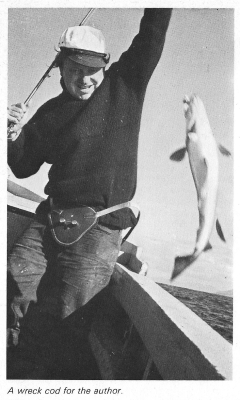
… In areas where cod are more plentiful, however, there is certainly a case for specialized fishing, and while pirks and eels, the former baited if possible, will account for plenty of fish, there is a commoner and rather less expensive type of multiple lure that will do at least as well and sometimes better. This is a trace of 'feathers' (or 'flies' if you are fishing in Scotland) tied on bigger hooks than normal mackerel feathers. These are very crude creations in comparison with, say, trout flies, but the principle is the same. As they are drawn through the water the fibres of the tied hens' feathers move and vibrate in a lifelike manner, although they may not look especially lively to the human eye.
For cod, the hooks should not be less than 6/0 and the dressing can be a personal choice though combinations of brown and white have proved to be consistently good. Some anglers use as many as six on a trace but this is asking for trouble. Three feathers will give the desired shoal effect and, even though it may be difficult to cope with three 10 lb plus cod at the same time, you do stand a chance of landing them. These feathers work better if they are baited with a strip of fish or even lugworm (the fish strip is better because it stays on longer).
Fishing a set of feather ures is simplicity itself. There is a lead, of course, at the end and the idea is to hit bottom and then jig the lures through the feeding zone from the wreck or sea bed to about five fathoms from it. Cod don't mass in and close to a wreck as coalfish and pollack do and it is always worthwhile fishing the clean ground within a radius of a couple of hundred yards of the wreck itself.
Of course there is nothing to prevent you from using plain, unadorned bait for cod on wrecks but you won't have such fast action as you will with baited feathers.
As I have said, cod don't fight that powerfully. The only trouble you are likely to have is when a strong tide is running and a cod opens that enormous mouth and kites away from you with the force of the current. This means that fairly heavy tackle is necessary where fish run large - and since in the eastern English Channel the fish spawn in March and later you are always liable to run into a forty-pounder. This means that you should not really go lighter than 30 1b line, and if you are not too experienced then 50 lb test monfilament will not come amiss in your first season anyway.
"Sea Fishing For Fun" (1977) Alan Wrangles & Jack P. Tupper at pages 73 & 86
5. Choosing and Storing Bait
Other baits and home-made lures
Sets of feathers are available at almost any tackle shop, and these can be used to catch mackerel, pollack, cod and codling. A set of feathers usually consists of twelve hooks, the feathers being whipped to the hook shanks, and each hook tied to a short length of stiff nylon snood which helps to stand the hooks clear of the backline. Feathers can be jigged or trailed behind a moving boat.
The Norwegians market an extremely efficient set of lures which consist of small plastic tubes, rather like 3in long sand eels. These alternate with small single hook spoons and, as lures, can be more effective than feathers.
6. How to Catch Fish
Fishing for bass
… or a feather-lure rig
At the other end of the scale you can use a dozen hooks dressed with feathers (a standard mackerel lure), with half a pound of lead tied to one end and a length of cod line to the other. While drifting or moving slowly ahead under power, either lower the tackle until the lead strikes the bottom and then slowly recover, jerking the lures as you do so, or stream them behind your boat. Halfway between the two extremes, the rod and line fisherman may use any one of a score of more sophisticated and expensive lures, lowered to the sea bed and then jigged and danced at varying depths. Whichever you choose, you are merely attempting to lure a predatory fish.
"Fisherman's Handbook" The Marshall Cavendish Volume 1, Part 5 (1977) Richard Walton at pages 120 to 123
How to Fish
Feathering
Hooks dressed with feathers are often used to catch mackerel, pollack, cod and whiting. Less commonly, bass and garfish are taken by 'feathering'. The tackle is set among a shoal and jerked up and down to simulate the erratic movement of small fish. The use of several feathered hooks helps create the impression of plentiful food. Once a shoal has been located a greedy mackerel, whiting or codling can often be taken on each hook.
Boat or Pier
This technique has been employed for generations in Scottish and North Eastern coastal waters, but has now spread to the South. Feathering is most frequently practised from a boat, using either a rod or a handline, wherever shoaling occurs. Pier anglers, again using either tackle, can also take advantage of incoming shoals.
The rig for feathering consists of up to six feathered hooks on traces or 'snoods' of about 5 in, which are attached to the reel line. A line of 15-20 1b b.s. should be used, for with a fish on every hook it will have to take a considerable load when being reeled in to a boat or a pier. The snoods should also be strong enough to avoid losing any fish when hauling in the catch and should be set 9-10 in apart so that they do not tangle. A fairly heavy lead should be used at the end of the reel line, for a smaller weight may take a long while to sink, by which time the shoal may have moved on, the feathers not having had a chance to attract them. For mackerel a size 1 or 1/O hook is suitable; for cod a larger hook, a 3 for example, is recommended.
When fishing for mackerel as bait (which is hard to beat for its appeal to many species) a six-hook rig will provide a plentiful supply. A group of boat anglers must remember though to be careful when swinging these multi-hook rigs in board, especially in a wind, for painful accidents and lost fishing time can result from lack of forethought.
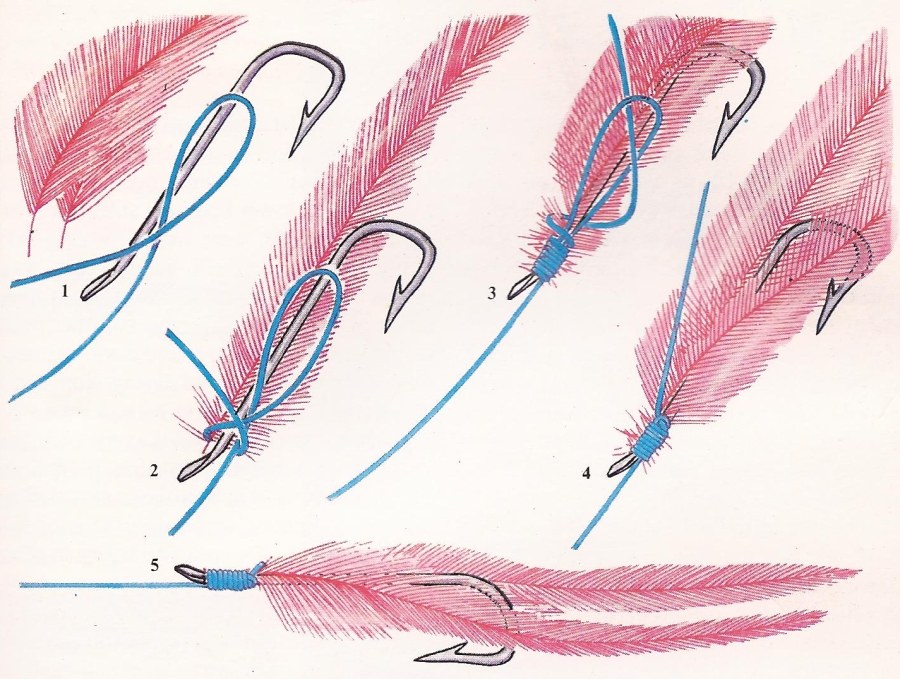
Feathered traces can be made simply.
The whip-knot is an easy one to tie by following the numbers from 1 to 5.
When the line is pulled through the last winding, make sure that all the turns are close and neat before pulling both ends tight and cutting off.
Three feathers only
The taking of large catches of mackerel in this way - and they are extremely easy to catch - is regarded by some as unsporting, and is very wasteful if, as is often the case, many fish are killed when not needed for bait or food. This is all the more serious when the mackerel, like other species, is being depleted rapidly by the growth of commercial fishing.
In any case, when the acquisition of bait is not the objective, the sport achieved with a single feather, especially one made to one's own design, is much more enjoyable. Combine this rig with a lighter rod and line for best effect. Single feathers provide a good opportunity for experimentation and, with practice, for fishing selectively. Bass, for example, have been caught on a lure made from a salmon fly to which two white feathers are added.
When fishing for larger species such as cod and pollack, it is impractical to use more than three hooks as the weight of these fish makes them considerably more difficult to boat than mackerel or whiting.
Traces of feathers can be bought ready-made from tackle dealers, but it is cheaper to make them yourself, using chicken feathers. These, taken from the neck, where the length and quality are best, are used in their natural white or can be dyed, usually in bright shades of blue, green, orange or red. They are whipped firmly onto sea hooks of a size appropriate to the fish sought, and are then ready to be attached to a snood made from the reel line.
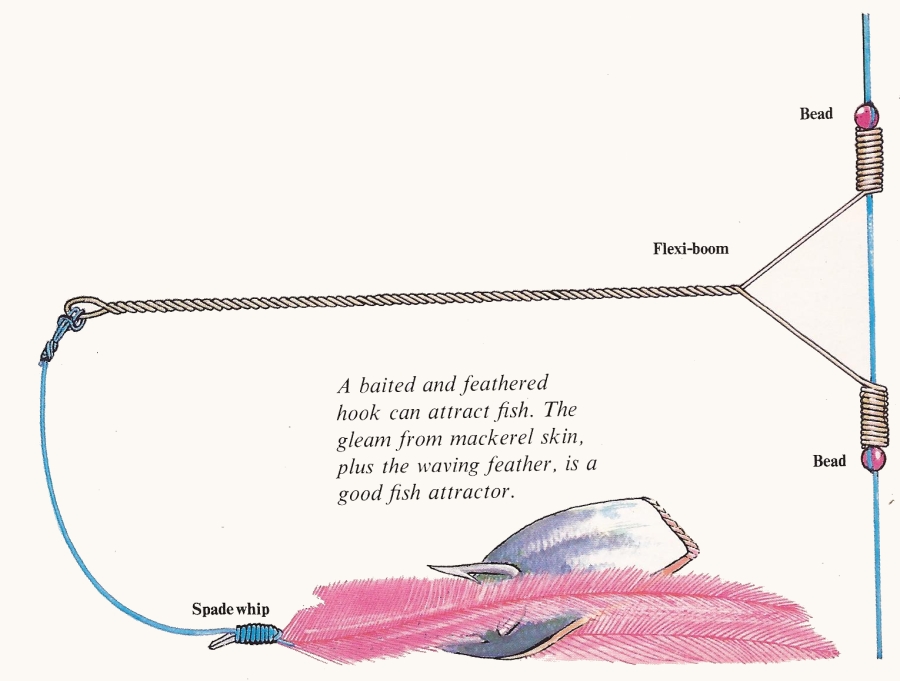
Baited Feather Rig
"The Guinness Guide to Saltwater Angling: Light tackle technique for British waters" (1977) Brian Harris at page 53
3 How to use the tackle: basic techniques
… Last of the shore techniques to be mentioned is fly fishing - which is also very useful when in a small boat, or an uncluttered large one. It will be dealt with in depth in chapter 11. The only point to note at this stage is that fly fishing on this side of the Atlantic is very little done (in saltwater) and it is usually only successful in very clear water conditions and from June to mid-October.
"Cod Fishing" (1978) Bob Gledhill at page 101
Chapter Four
Boat Fishing
Feathering
Feathering is probably the oldest form of lure fishing there is. Although these days feathers have been relegated to the lowly task of catching mackerel, the history of feathers for catching sea fish goes back hundreds of years.
I do not like the type of hook many feather tiers use on tackle shop feather flights. They are the tinned, spade-end hook with a monstrous barb. I wouldn't use them on the shore so I won't use them on a lure. I tie up my own feathers for cod fishing, using feathers I find, though if you have difficulty in getting white feathers (the colour I prefer) just walk into a poulterer's shop and ask to buy a few chest feathers of a white bird. Odds are on he will give them to you if you explain what you want the feathers for.
I use stainless steel 3/0 hooks, stainless so that the hooks won't rust up between use. I tie a good cluster of down feathers to the shank, and use just three feathers per flight, fastening them on snoods of heavy line just a couple of inches long.
There is an even simpler way than this of making feathers, and that is to dispense with real feathers altogether and just fold over a two inch piece of chrome Sellotape over the hook shank, with about half an inch trailing off the hook.
The wet feather is meant to imitate a small bait fish like whitebait or brit, and nothing flashes more realistically than a strip of chrome tape.
I wouldn't claim feathering to be a first choice method of catching cod, but it is especially worth setting up a flight if you get among a shoal of small to medium-sized codling, putting a lure on the bottom hook instead of a plain weight.
You can, of course, tip the feathers with a piece of bait - a small worm or a piece of fish. It appears that fishing in this way is neither one thing or the other, but it works, so you can't knock it too hard. But again, it has worked best in my experience with small codling.
The Daily Mirror, Saturday 27 October 1979 at page 20
Fishing Tip by Hal Mount
Sometimes when using conventional feather lures, mackerel tend to come short, snatch at the feather and miss the hook. Bournemouth angler J. Sevior experimented by cutting the feathers back to half an inch beyond the hook bend and it paid off.
"The Fisherman's Guide to Sea Fishing" (1979) Eric Shults at pages 144 to 147
Feathering
Mackerel Feathers
Hooks dressed with feathers are often used to catch mackerel, pollack, cod and whiting. Less commonly, bass and garfish are taken by 'feathering'. The tackle is set among a shoal and jerked up and down to simulate the erratic movement of small fish. The use of several feathered hooks helps create the impression of plentiful food. Once a shoal has been located a greedy mackerel, whiting or codling can often be taken on each hook.
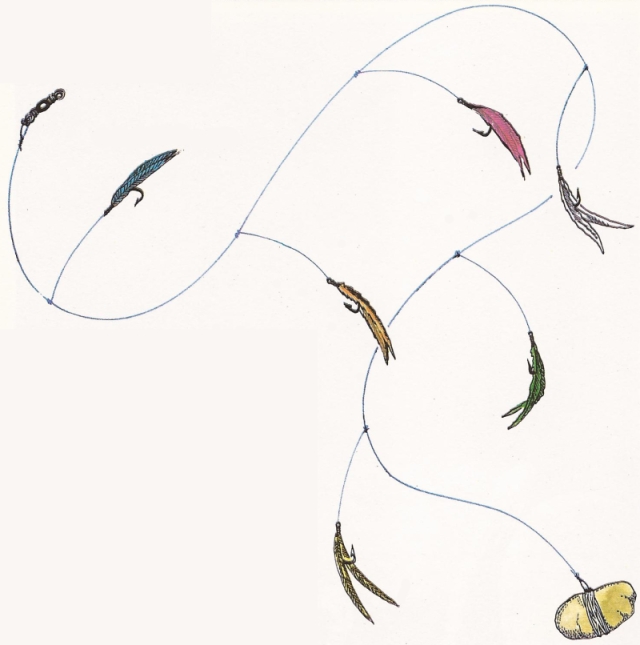
Mackerel can be taken in large numbers on six-hook feathered traces. The feathers, coloured, resemble small fish
Boat or pier
This technique has been employed for generations in Scottish and North Eastern coastal waters, but has now spread to the South. Feathering is most frequently practised from a boat, using either a rod or a handline, wherever shoaling occurs. Pier anglers, again using either tackle, can also take advantage of incoming shoals.
The rig for feathering consists of up to six feathered hooks on traces or 'snoods' of about 5 in, which are attached to the reel line. A line of 15-20 1b b.s. should be used, for with a fish on every hook it will have to take a considerable load when being reeled in to a boat or a pier. The snoods should also be strong enough to avoid losing any fish when hauling in the catch and should be set 9-10 in apart so that they do not tangle. A fairly heavy lead should be used at the end of the reel line, for a smaller weight may take a long while to sink, by which time the shoal may have moved on, the feathers not having had a chance to attract them. For mackerel a size 1 or 1 /0 hook is suitable; for cod a larger hook, a 3 for example, is recommended.
When fishing for mackerel as bait (which is hard to beat for its appeal to many species) a six-hook rig will provide a plentiful supply. A group of boat anglers must remember though to be careful when swinging these multi-hook rigs in board, especially in a wind, for painful accidents and lost fishing time can result from lack of forethought.
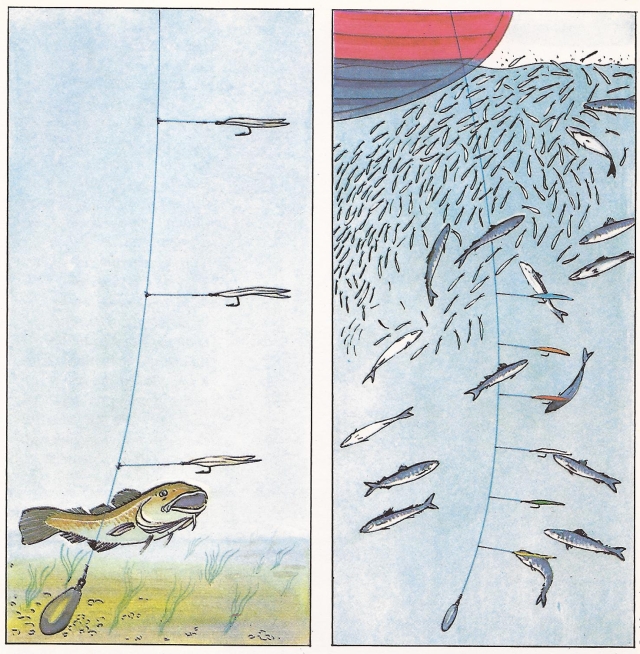
Cod feathers come from white chickens. While they can be 'worked' in the way mackerel feathers are pumped up and down, cod can be caught by allowing the feathers to stream out
Three feathers only
The taking of large catches of mackerel in this way - and they are extremely easy to catch - is regarded by some as unsporting, and is very wasteful if, as is often the case, many fish are killed when not needed for bait or food. This is all the more serious when the mackerel, like other species, is being depleted too rapidly by the growth of commercial fishing.
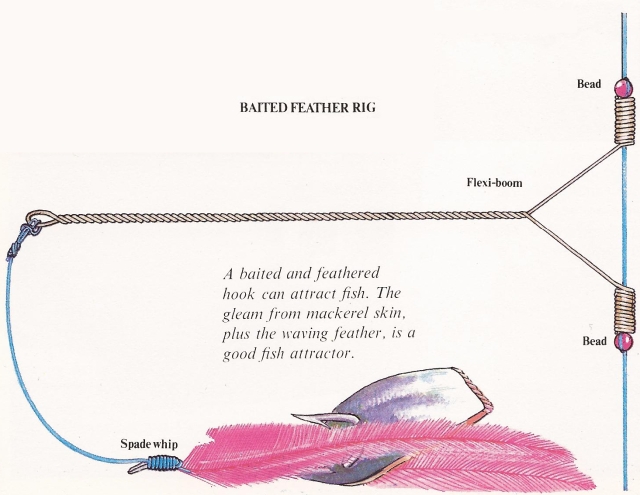
In any case, when the acquisition of bait is not the objective, the sport achieved with a single feather, especially one made to one's own design, is much more enjoyable. Combine this rig with a lighter rod and line for best effect. Single feathers provide a good opportunity for experimentation and, with practice, for fishing selectively. Bass, for example, have been caught on a lure made from a salmon fly to which two white feathers are added.
When fishing for larger species such as cod and pollack, it is impractical to use more than three hooks as the weight of these fish makes them considerably more difficult to boat than mackerel or whiting.
Traces of feathers can be bought ready-made from tackle dealers, but it is cheaper to make them yourself, using chicken feathers. These, taken from the neck, where the length and quality are best, are used in their natural white or can be dyed, usually in bright shades of blue, green, orange or red. They are whipped firmly onto sea hooks of a size appropriate to the fish sought, and are then ready to be attached to a snood made from the reel line.
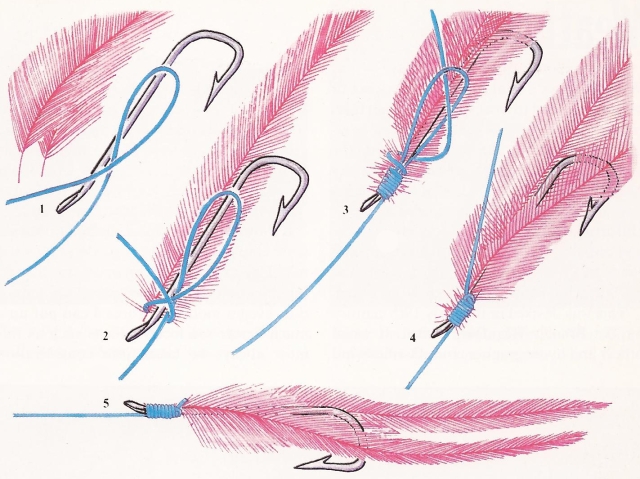
Both mackerel and cod feathers can be bought quite reasonably from your local tackle shop. But feathered traces can be made simply. The whip-knot is an easy one to tie by following our numbers from 1 to 5. When the line is pulled through the last winding, make sure that all the turns are close and neat before pulling both ends tight and cutting off.
"The Complete Book of Sea Fishing: Tackle and Techniques" (1992) Alan Yates and Jed Entwistle at pages 72, 73 & 106
7. Pier Fishing for Cod, Whiting, Pouting, Pollack, Mullet and Mackerel
Fishing for mackerel from piers
Mackerel are occasionally taken on bait whilst fishing for other species from the pier, but they are more deliberately fished for with feathers and lures. The technique is generally frowned upon by serious anglers, with mackerel considered as a legitimate angling target only when they are needed for bait. However, thousands of anglers fish for mackerel from piers during the summer months when they are an easy target for the holiday angler or novice.
Feathering is the most effective technique to catch mackerel which, when shoaled up and feeding on the small whitebait and brit, work themselves into a frenzy, grabbing anything that moves. Feathered lures work well, but even bare silver hooks or silver paper wrapped around a hook will take fish in this situation - huge bags can be caught by the novice with ease, simply by dragging six bright lures through their midst, sink and draw. The greed promoted in us by such easy fishing means that anglers catch many more fish than they can carry home, and on occasions dead fish are dumped back in the sea. Hence the unfortunate reputation that feathering has gained amongst the majority of anglers. This is a pity because the mackerel is one of the speediest fighters in the sea, and on light spinning gear he has few rivals. A single lure on a light spinning outfit fished from the pier at dusk is a fun way to catch mackerel for bait or for the pot.
There are a few points worth noting about feathering for mackerel: first, a warning about the commercial mackerel feathers on sale. Most are tied with inferior knots and in line which is too light. A snapped-off lead poses much danger on a pier crowded with mackerel anglers, and my advice is to buy ready-tied feathers with care. Failing that, you can make up your own or retie the commercial sets using stronger line.
Some of the dayglow designs are very effective, but they do tend to fall to pieces after catching a few fish. I prefer to tie my own feathers and use trout lures for the job. These smaller and more deliberate designs will catch pollack, whiting, bass, lance, coalfish, pout, scad and mackerel, and they bring a new dimension to feathering. The most effective flies include Jack Frost, Appetiser, Missionary, Zonkers, Whisky, Dog Nobblers and Cat's Whisker. These lures can be purchased in hook sizes ranging from 6 to 12, and although they are a little on the small size for mackerel, they are ideal for several other species. Alternatively if you know a fly tier, get him to tie the lures on bigger hooks such as 1s or 2s. The lures can be made up on rigs of three or four with 4in (10cm) snoods. There is no real need for sets of six, as a rig full of mackerel is difficult to pull up the pier wall.
Fish the lures 'sink and draw' - lift the rod and then reel in as you lower it down again. The speed of the retrieve and the depth to which the lures are allowed to sink, gives the angler the means to search the different levels of the water for fish. Another method which works on occasions is to creep the lures slowly along the sea-bed. A heavy lead improves the standard sink-and-draw feathering technique, as it increases the speed of the lures as they sink. Thus fish are attracted to the lures both as they are lifted and as they sink. If you are filling the freezer with bait or simply catching mackerel to eat, a coolbox and a couple of ice packs keep the fish fresh. Gutted as they are landed and transferred to the coolbox, they will arrive home fresh, and will also keep in much better condition if being used for bait in the future.
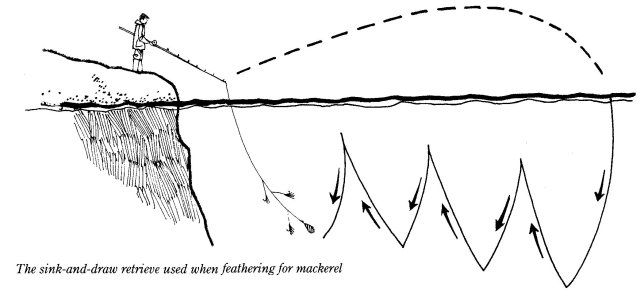
11. Tackle Basics
Mackerel Feathers
A set of mackerel feathers, or variations on them - slivers of insulation tube or strips of Flectotape - is the commonest lure in sea angling and one of the boat angler's prime sources of bait. Though strings may be of a dozen feathers or more and most retail sets contain six, many anglers will only use three feathers. This is primarily because according to the National Federation of Sea Anglers and the rules of most clubs, fish caught whilst angling with more than three hooks would not be recognised.
There is a knack to consistent mackerelling. Most mackerel are taken on the drop, but of course the lures don't want to be travelling too fast, so allow the weighted feathers to drop for a dozen feet or so, then stop the spool with your thumb. Lift the rod tip, and repeat until you find the fish. Work down to the sea-bed, retrieve and start again when fish are scarce. On those days when you find the fish consistently you will soon know how far to drop your lures.
"The Art of Wreck Fishing" (1996) Stu Arnold at page 77
7. Drifting with Pirks
There are many variations of terminal tackle fished in conjunction with a pirk, the most common being feathers.
There are endless types of cod feathers on sale in the shops today, most of which are made to catch anglers, not cod, with either hooks set too close to each other, nylon line that is far too light and will snap even with a small cod bouncing on the rod tip, or the wrong colours.
Most feathers are made and sold with 6 hook/feathers to a trace; this is far too many, the most needed is three, so if you buy a set of 6 cut it in half and increase your chances of landing 2 or 3 fish in one time.
The only cod feathers made commercially for sea angling that I would personally recommend are made by Brent Tackle of Hailsham, East Sussex, because they are made on 90lb line, with good sharp commercial cod hooks/feathers in a size 8/0, and have never let an angler down by snapping, or from a bad knot coming undone, that I know of. It's a shame that other manufacturers do not realise the importance of these points, relying on the angler snapping up the line on a set, thinking he will buy other sets, rather than making a decent quality product to catch fish.
All white feathers are best and will take pollack as well as cod on the same rig. Multicoloured feathers are pretty at Christmas, that's about all.
Feathers can also be baited in conjunction with a pirk, mainly to attract ling rather than cod, which go for movement more than smell.
"Cod Fishing: The Complete Guide" (1997) Dave Lewis at pages 45, 46 & 66 to 69
3. Artificial Lures for Cod Fishing

Feathers
Feathers are perhaps the oldest type of lure in the sea angler's armoury. A string of up to six brightly coloured hen hackles is also one of the most productive methods of general reef fishing, as will be seen later, and bait collecting. However, shop-bought feathers are rarely tied using quality nylon and hooks, and as such are totally unreliable for serious cod fishing. On many occasions I have seen an angler drop a set of feathers into the depths and his rod buckle in two as several sizeable fish have smashed into the lures. Unfortunately, the combined weight and pulling from several sizeable fish will almost always result in a smashed trace, and the angler, if he is lucky, ends up with just one or two fish.
The exception to the rule are the purpose-made traces of cod feathers produced by Mustad. These are tied using heavy mono and strong hooks. Personally, I am not a tremendous fan of feathering as a sporting technique, but if you do want to use feathers for cod, I strongly suggest you use a decent set.
These days there are many alternatives to natural feathers in the shops, ranging from bright strips of tinsel to long thin strips of reflectolite plastic. Some of the very best modern alternatives are known as Hokeye lures. These consist of a small luminous rubber fish-shaped body with a reflectolite tail and a luminous bead mounted on the track at the head. These are devastatingly effective. Once again, Mustad produce a heavy-duty range suitable for cod fishing, the Hokeye Tempter Rig, which consists of three lures tied using 4/0 hooks to 60lb BS line. Feathering is an excellent technique for novice and junior anglers.
4. Boat Fishing for Cod
Feathering
Both lures and baits, or a combination of both, are used when drifting a reef for cod. I suppose a string of feathers is the most widely used type of lure among anglers for this type of fishing. The best type to use, when you can get hold of them, are those which are tied specifically for cod fishing. These are available in traces of between three and six feathers, in either plain white or a selection of different colours. Cod feathers are tied using stronger line and larger hooks than the more readily available mackerel feathers. I prefer using plain white feathers when cod fishing.
… I do not generally favour using multiple-lure rigs for fishing, much preferring to catch fish on an individual basis. However, I have found that the action of a set of up to six feathers working together is, on occasion, more likely to produce a take from a single cod than a feather or similar lure fished singly. I suppose it is more natural for the cod to see several bait fish swimming together ?
The feathers are weighted using either a plain lead or a pirk. The trouble with using a pirk over some reefs is that it is far more prone to snagging on the sea bed than a plain lead. That said, I am convinced that it is far more effective to use a pirk with either the hooks removed or the standard treble replaced with a single hook, as the flashing and added action of the pirk undoubtedly helps to attract fish.
Many anglers use baited feathers, typically long thin strips of fish or squid, peeler crab, ragworm or mussel. The addition of bait can make a big difference when fishing a reef, and also increases the likelihood of catching other species such as wrasse, coalfish, pollack, bream, gurnards, etc. But I am convinced that plain feathers are just as effective for cod as baited feathers, with the possible exception of small codling which are more likely to take a bait than a lure.
Feathers are really very easy to fish. All the angler has to do is to drop them to the sea bed and bounce them around, but there are a few tips and subtle adjustments which will improve the overall efficiency of the basic technique. Whenever fishing over a very snaggy area it is wise to attach the weight via a short length of weak line known as a rotten bottom, to help minimize tackle losses should the lead become snagged. Another useful trick which reduces tackle losses, especially when there is a lot of kelp on the bottom, is to cut a standard string of six feathers into two separate sets of three. Obviously, this halves the likelihood of a hook getting snagged.
It is important that the feathers are fished in as near to a vertical line as possible. Not only are they more effective when fished vertically beneath the boat, but they are far less prone to snagging than if they are trailing many yards astern of the boat. For the best results when specifically targeting cod over a reef, keep the feathers working on or very near to the sea bed, even at the risk of getting snagged up sometimes, as this is where most cod will be feeding.
In recent years a wide variety of modern alternatives have arrived in the tackle shops, all but replacing the traditional hen hackle feather. I have tried many of these and most are really no better than natural feathers when fishing for cod, only considerably more expensive. There are, however, a few exceptions to the rule. I particularly like rubber squids or muppets as they are called, which can often sort out the better-quality fish.
The other really effective lure is the Hokeye, and its many variations. These are very effective - too effective in fact - and when used over a reef the angler who is specifically targeting cod should be prepared to catch just about everything else that is swimming near the bottom as well !
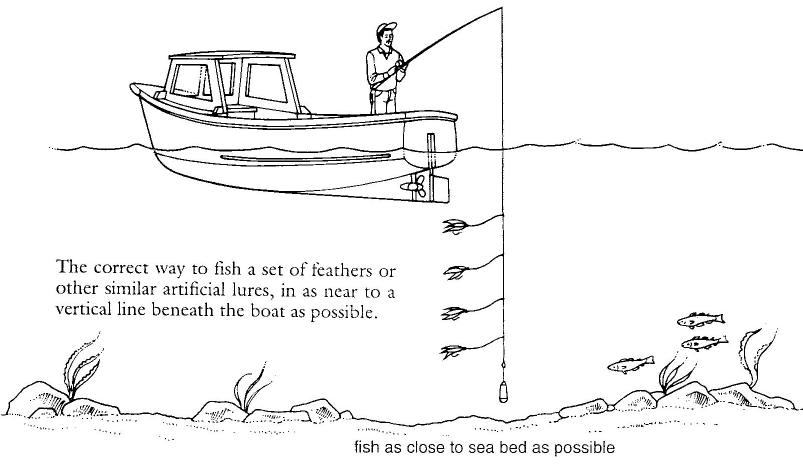
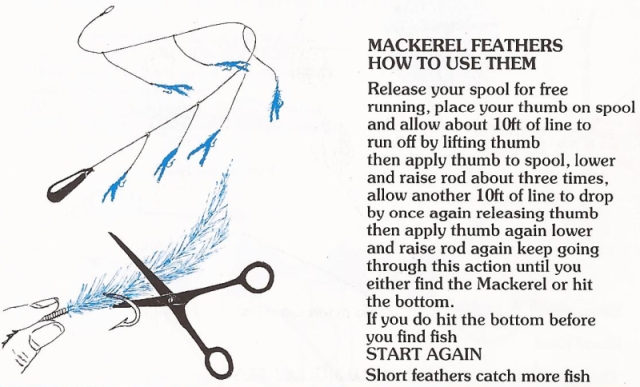
"Hooked on Sea Angling" (2011) Martin & Dave Beer